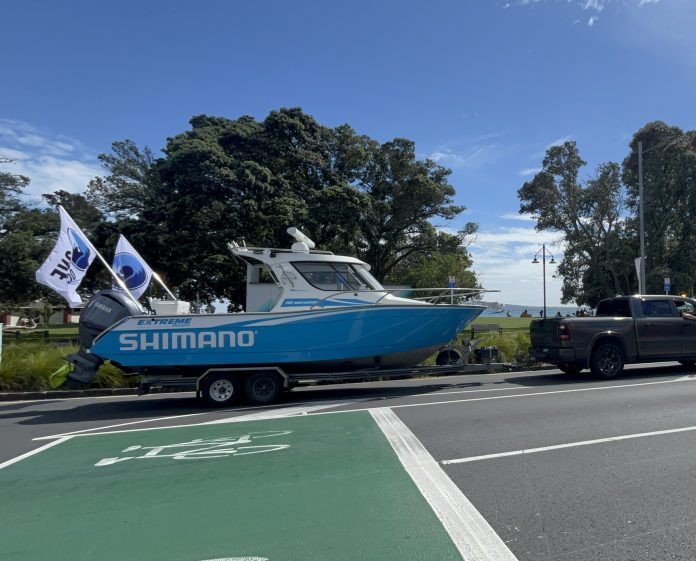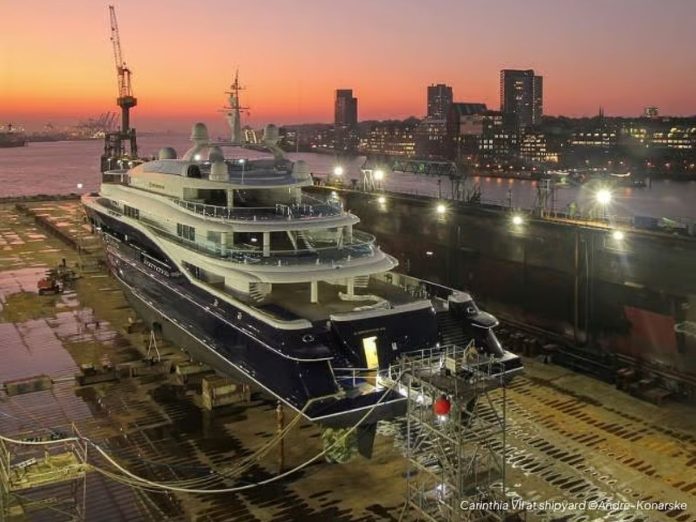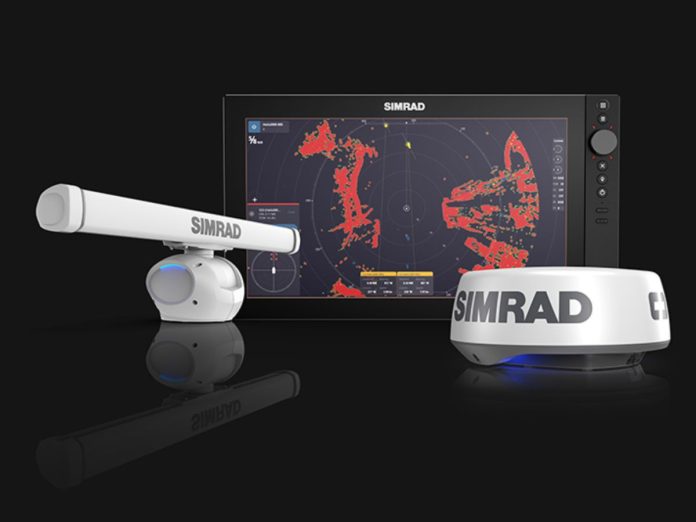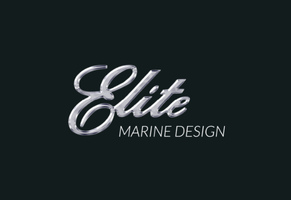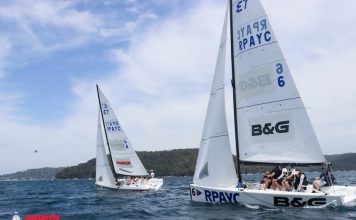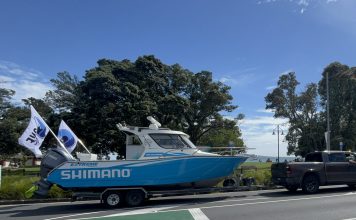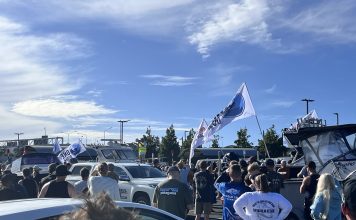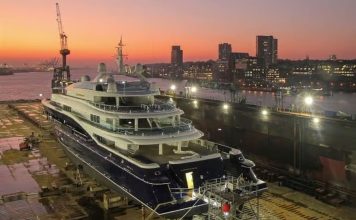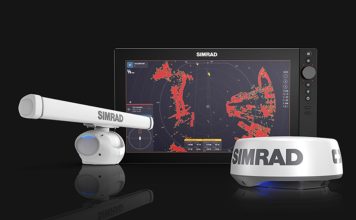Rayglass Boats’ new Legend 2700 is the spiritual (and, eventually, literal) successor to the Legend 2500, the Auckland-based company’s most successful model, with almost 600 in circulation. Rayglass’ latest offering promises as much and more.
Check out the really neat walkaround virtual tour.
Developed from the award-winning 2500, the 2700 shares the same hull and an identical waterline length but is longer and wider internally, with more internal volume and more angular styling. Developed using almost 20 years of Legend 2500 customer feedback, the design team tried to address all the things that customers didn’t like and improve on all the features they loved, according to Rayglass founder Tony Hembrow.
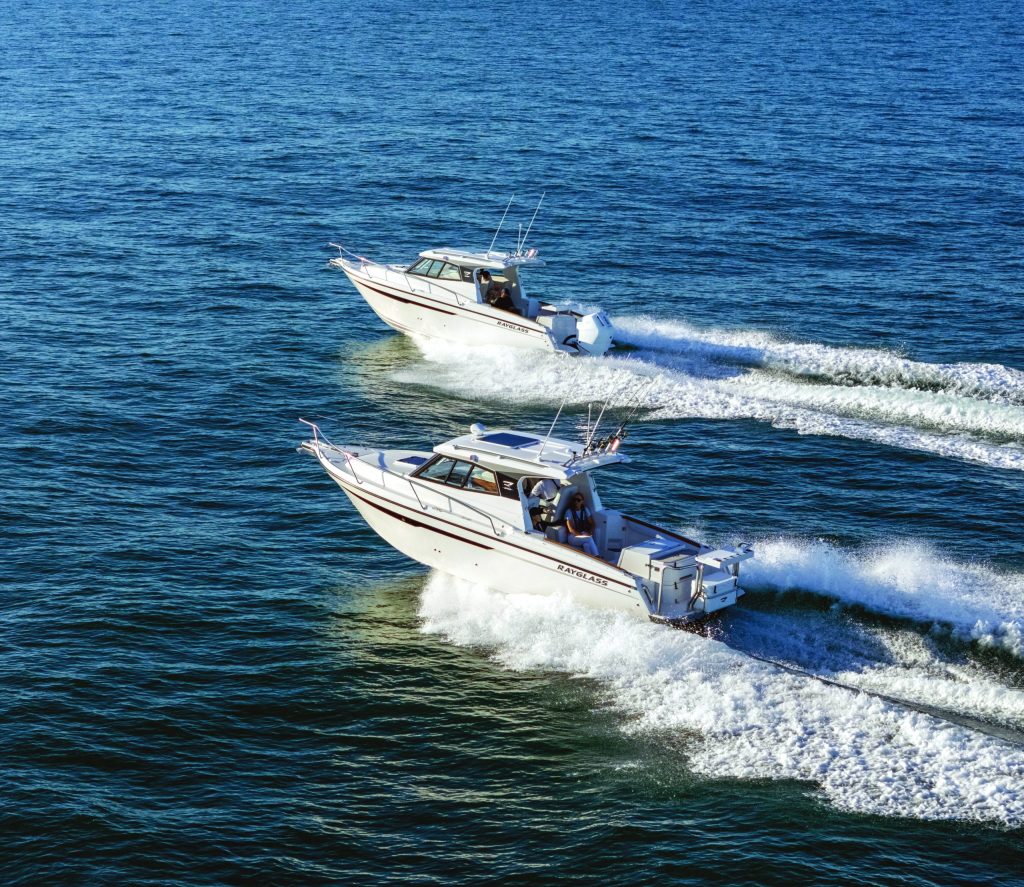
Available in sterndrive (petrol or diesel) or outboard configurations (single or twin), the majority of which come in at under 3500kg on an Alloy Tech tandem braked aluminium trailer, the Legend 2700 promises to be a winner for Rayglass. We compare the diesel and single outboard models.
Fresh styling
There’s a great deal about the new 2700 that looks and feels familiar. While the styling is fresh, it’s evolutionary, so there’s an unmistakable ‘Rayglass look’ to the boats, though the new, more angular lines perfectly reflect mid-2020s sensibilities. The detailing, high-quality fit-out, and finishing are standard Rayglass, as is the foam-filled, unsinkable hull – expected but always appreciated.
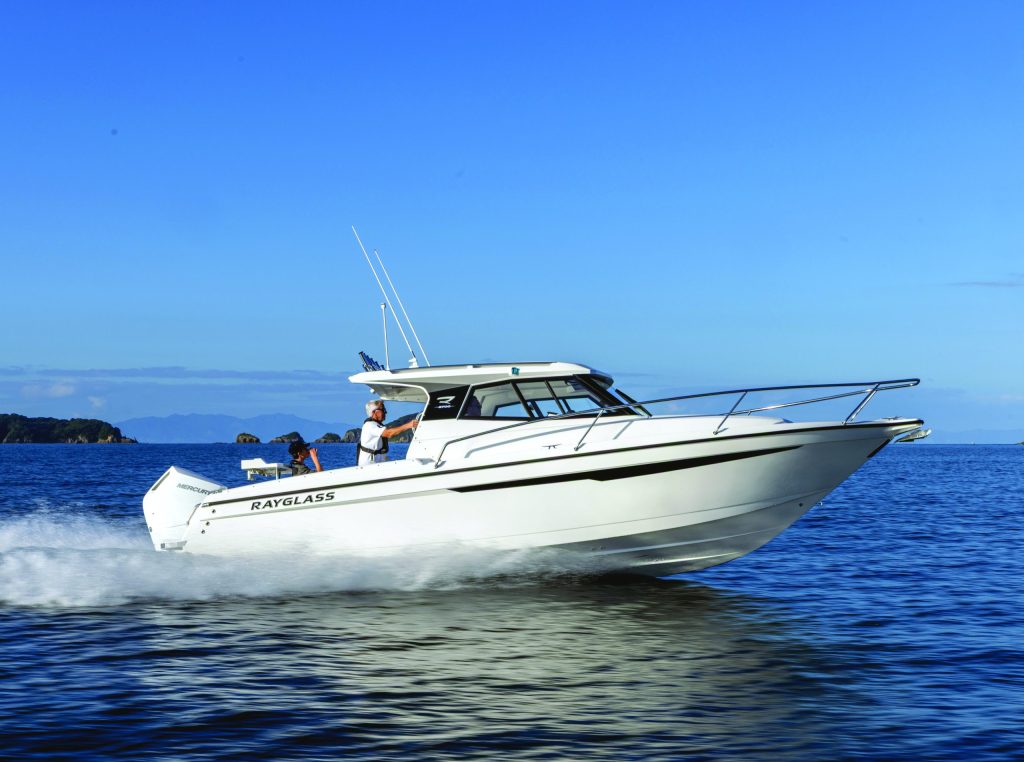
The new Rayglass models (including the Legend 3000, which shares the 2700’s cabin, hardtop, transom options, and much more) are a perfect style match for Mercury Marine’s futuristic, angular engine styling. It’s fair to say the Verado 400hp V10 and 2700 look great together, as though they were made for one another.
Modular transom
The sterndrive looks good too. Its rear platform is deeper than the outboard models’, providing a dedicated fishing, diving, and water activity zone – or somewhere to store a tender. The platform comes with pull-out stainless corner rails that also rotate, a superb Rayglass moulded fibreglass bait table (with a reversible cutting board to accommodate a BBQ) and the choice of several transom layout options. On the boat we enjoyed, there was a deluxe Rayglass chilly bin, moulded from fibreglass, in addition to an Icey-Tek bin under the bait table, but the deluxe bin can be swapped out for an aft-facing seat.
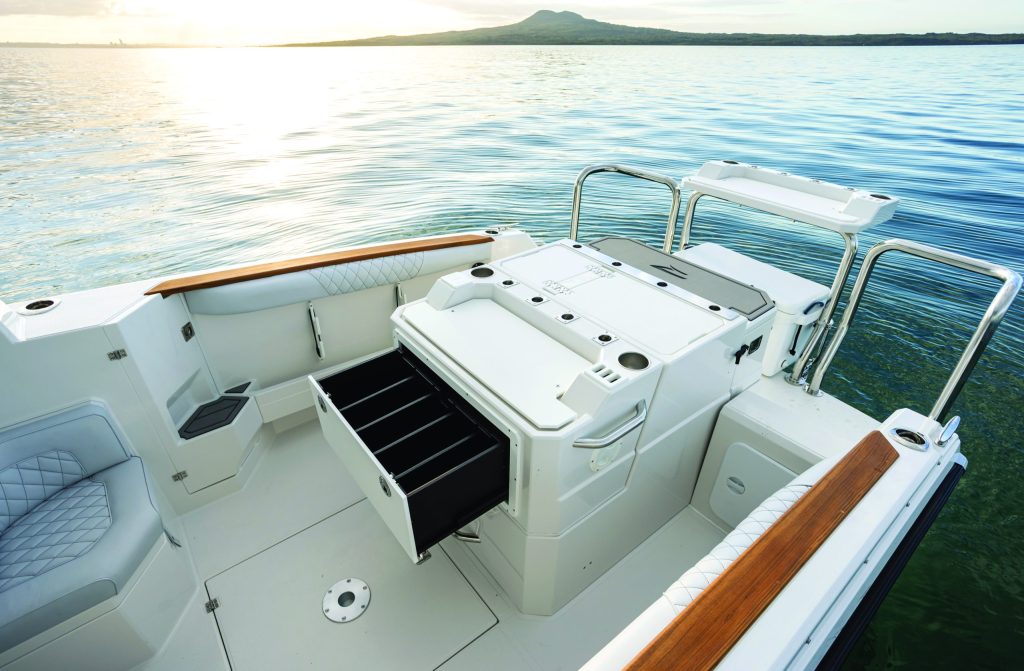
The sterndrive engine box has the same footprint as the transom island on the outboard versions, which all take up a bit of cockpit real estate. With the sterndrives, you could argue that any loss is made up for by the expansive, caged aft platform. However, there is good access to the transom step-throughs on either side of the engine box, which is also handy to brace against while fishing.
The transom island accommodates either a forward-facing seat or a drop-in fishing box module as reviewed, with tackle drawers, additional vertical rod holders, cup holders, and knife racks. Equipped with a reversible moulded cutting board that drains into the sump, it’s a doppelganger for the bait station on the platform.
On sterndrive models, the workstation aft has four vertical rod holders across the back and a PVC work surface over the live well and plumbed sink. Outboard versions get a slightly smaller sink and live well. A hot water cylinder for the cockpit shower and galley lives in the transom locker to port with the washdown pump in the starboard locker.
The cockpit is very clean. U-Dek flooring, or removable carpets are an option, but the review boat was presented ‘naked’ with easy-clean non-slip moulded decks. Floor-level cockpit LED strip lighting is nice, as are the underwater lights. The cockpit drains via stainless steel scuppers in the corners into the bilge aft, where the water is automatically pumped out. Deep drains around the engine box do the same.
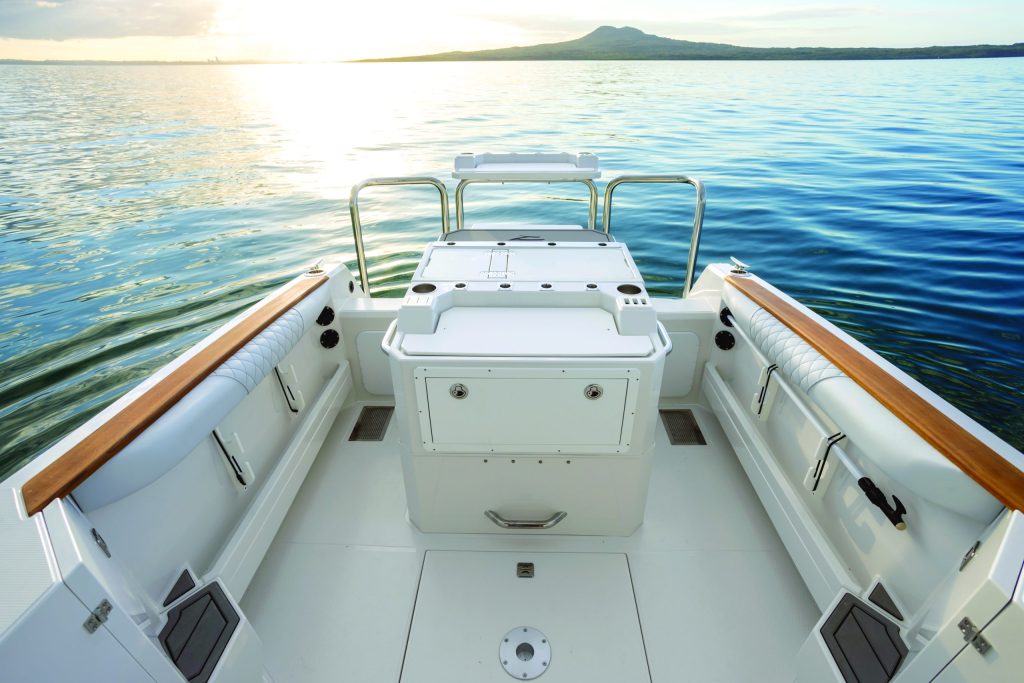
Side pockets afford good toe-room with under-gunwale racks for rods, gaffs, poles and the like. All versions have dedicated internal rod storage extending alongside the hardtop cabin on the starboard side suitable for four rods,
a Rayglass signature, as well as stainless steel through-gunwale combination cup and rod holders, plus rocket launcher and bait station rod racks. There’s fender storage on the port side, also accessible by lifting the seat, and moulded steps on either side to access the side- and foredecks.
Unlike the rounded foredeck of the 2500, the 2700 foredeck is flat with wider side decks and hardtop grab rails for secure transit to the bow, where
a sun lounger pad is an option. The 2700 also has a larger anchor locker with better fall, so there’s less chance of warp and chain foul-ups, and the aerials have been moved from the sides of the hardtop to the roof so as not to impede access forward.
For the sterndrive, Rayglass has completely sealed the engine compartment from water ingress, the batteries have been relocated from the transom to the front of the engine box, and all of the service points are easily accessible. All versions see the battery isolation switches moved to beside the helm for easy operation.
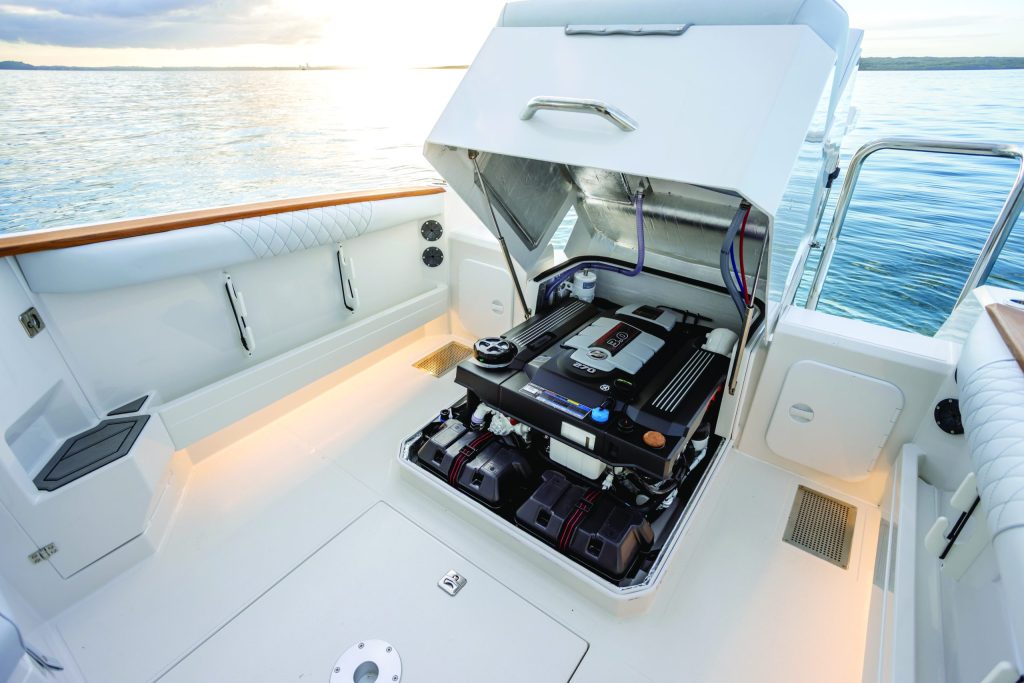
The outboard version is identical to the sterndrive from the seats forward but has
a different transom arrangement with swim/boarding steps either side of the single outboard and with a clear walkway in front of the engine. Twin rigs lose more swim step but keep the walkway.
Like the sterndrives, there’s plenty of scope to personalise the layout with a range of transom modules available. These include a transom seat as reviewed or drop-in fibreglass or Icey-Tek fish boxes instead of the seat. The deluxe moulded Rayglass bait station has two positions, one more inboard and one further aft. A live well and sink are moulded into the transom island with the batteries under the seat base.
A huge underfloor storage locker with a lift-out bin is big enough for dive bottle racks.
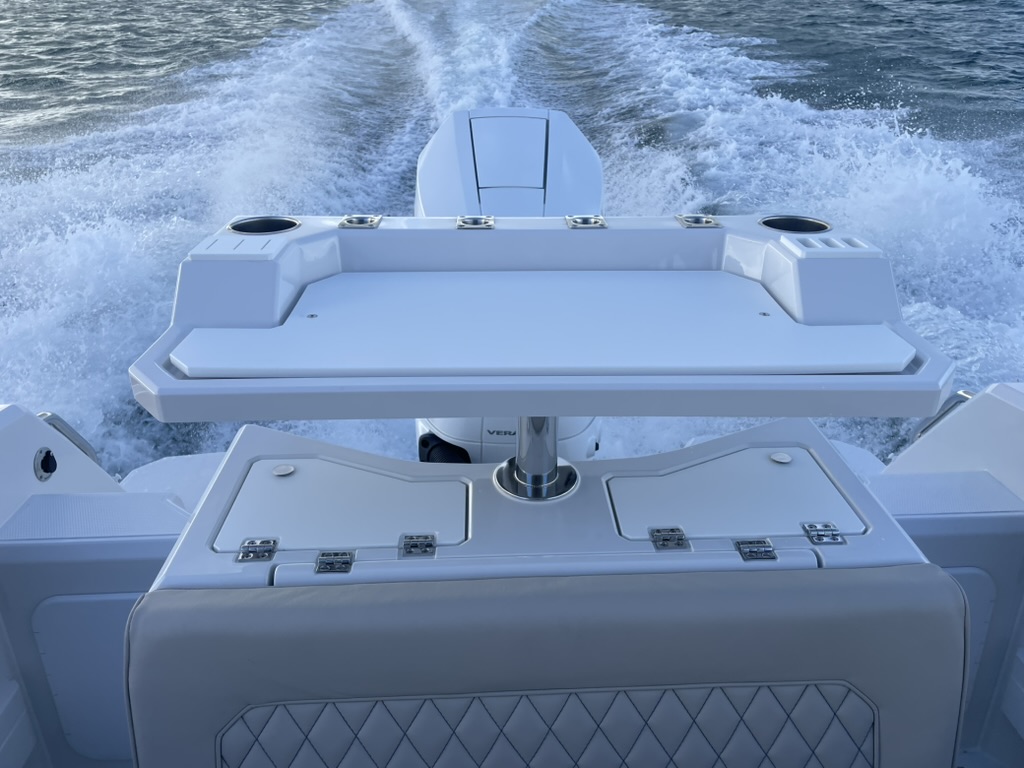
More volume
From here forward, the Legend 2700 is identical regardless of which version you choose, including a range of canvas and clear backdrops and side curtains. The extra length and volume above the waterline has allowed Rayglass to make the galley more functional with additional storage and more room to work in. The separate toilet is roomier too, and there’s more length in the forward cabin to stretch out – Rayglass offers a deluxe overnighting package with mattress liner and linen, which ensures a super-comfortable double berth. The cabin is also wider and lined in premium vinyl panels that complement the solid teak trim and fully wraparound shelving is another new feature.
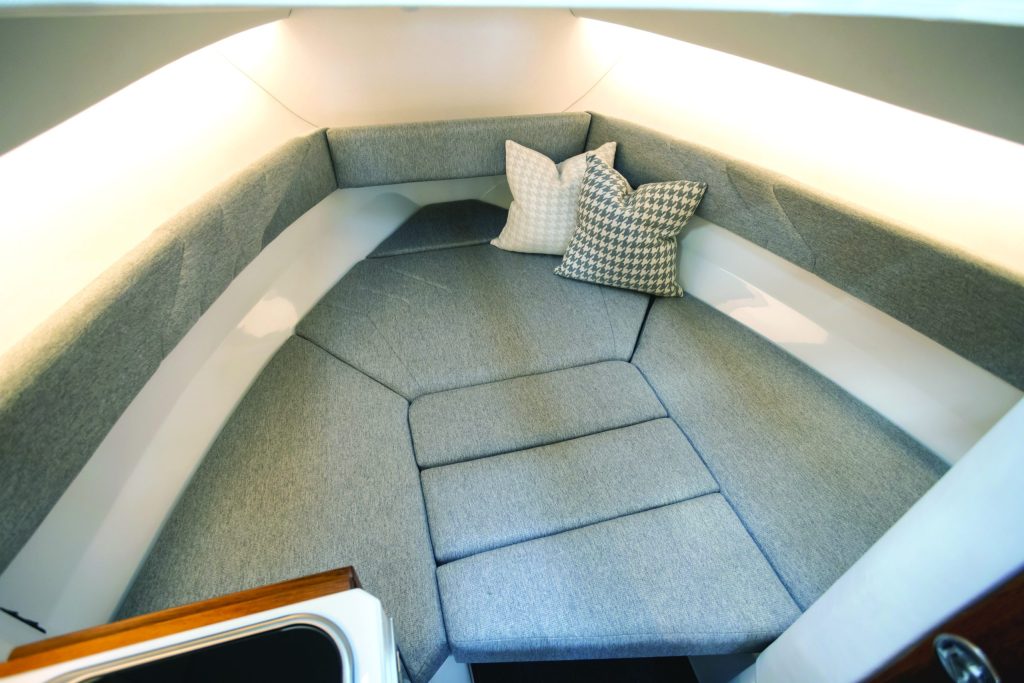
The extended hardtop is extremely functional but also very premium in terms of fit and finish. The mouldings are perfect, and the fabric and marine vinyl upholstery are both durable and stylish. Suspension captain’s chairs are not only comfortable, with fore and aft and up and down adjustment, but they also swivel to face aft. The folding seat bolsters provide good support when standing and thigh support when seated, the armrests fold up, and the footrests are adjustable too.

Rayglass has also opted for two-pane, flat glass windscreens and solid mullions (three), which improve overall rigidity (no squeaks) and are easier to seal. Windscreen wiper-washers can now also sweep the whole of the screen. Side windows are glass, with sliding panels fore and aft, while a manual, two-position sliding sunroof affords even more ventilation and light.
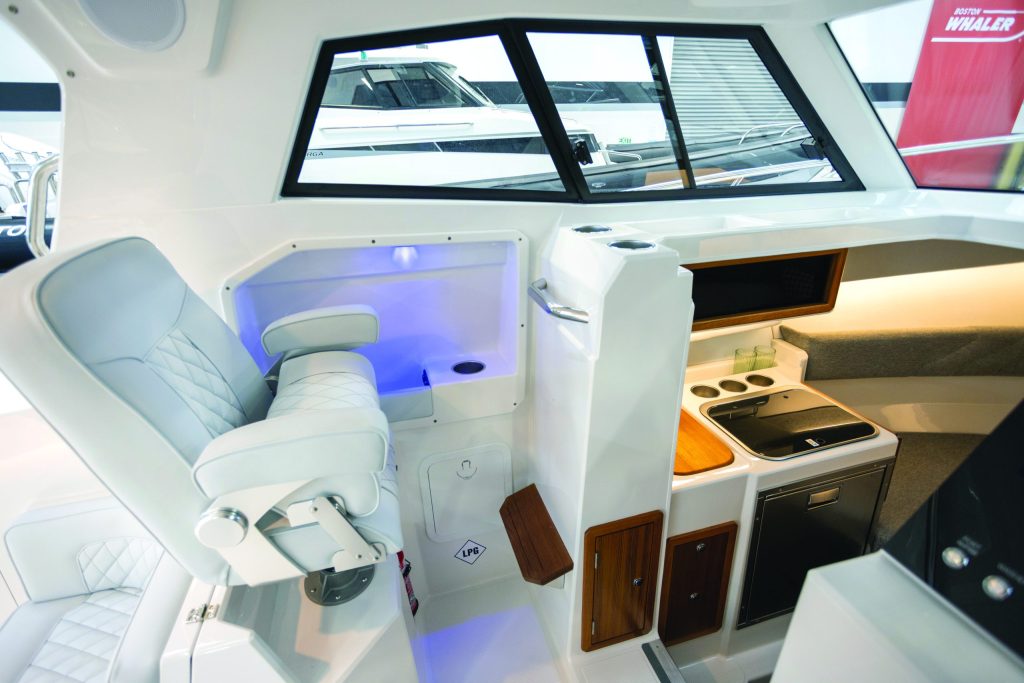
Similar but not the same
Underway, the two models we tried have quite different characters. The sterndrive with its 270hp, three-litre turbodiesel feels planted in the water and relaxed at cruising speed. The outboard version, featuring Mercury’s 4.7-litre, 400hp V10, is a faster, more sporty ride with livelier handling and more responsive performance.
All versions share the same integrated helm console layout with the latest Simrad NSS4 16-inch multifunction display and Mercury Vessel View display prominent and push-button switches arrayed across the bottom. The throttle control is set into a deep side pocket where it falls naturally to hand. This pocket, and its twin on the port side, also provide space for cell phones, wallets, and keys – there’s a MagSafe charger on the console fascia, too.
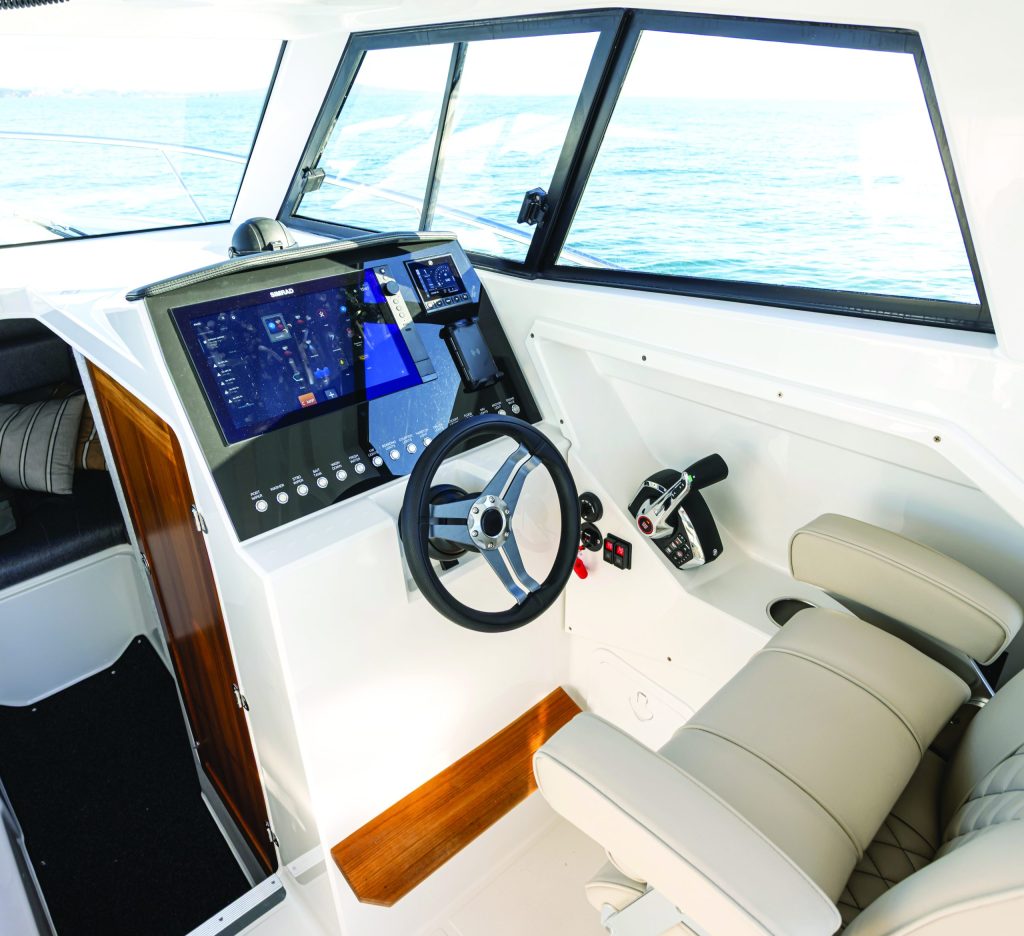
The sterndrive 2700 was fitted with Lenco’s new Pro-Control automatic trim tab system, which worked a treat in automatic mode but could also be adjusted on the fly to raise or lower the bow while still automatically controlling roll. The easy-to-use controller was mounted in the pocket just above the throttle.
At the helm is a comfortable place to be. The diesel is not noisy exactly, though there is a bit of turbo whistle, but it’s quite possible to hold a conversation at cruising speed. Top speed is around 33 knots, and she cruises happily at 24 knots, burning 35 litres per hour.
The Mercury V10 offers quite a bit more in terms of performance, leaping onto the plane and feeling extremely responsive to throttle inputs. Top speed exceeds 42 knots; at 25 knots the Mercury is spinning at 4000rpm and burning 45 litres per hour. With a fuel capacity of 320 litres under the floor, the V10 2700 has a useful range in excess of 300 nautical miles at cruising speed.
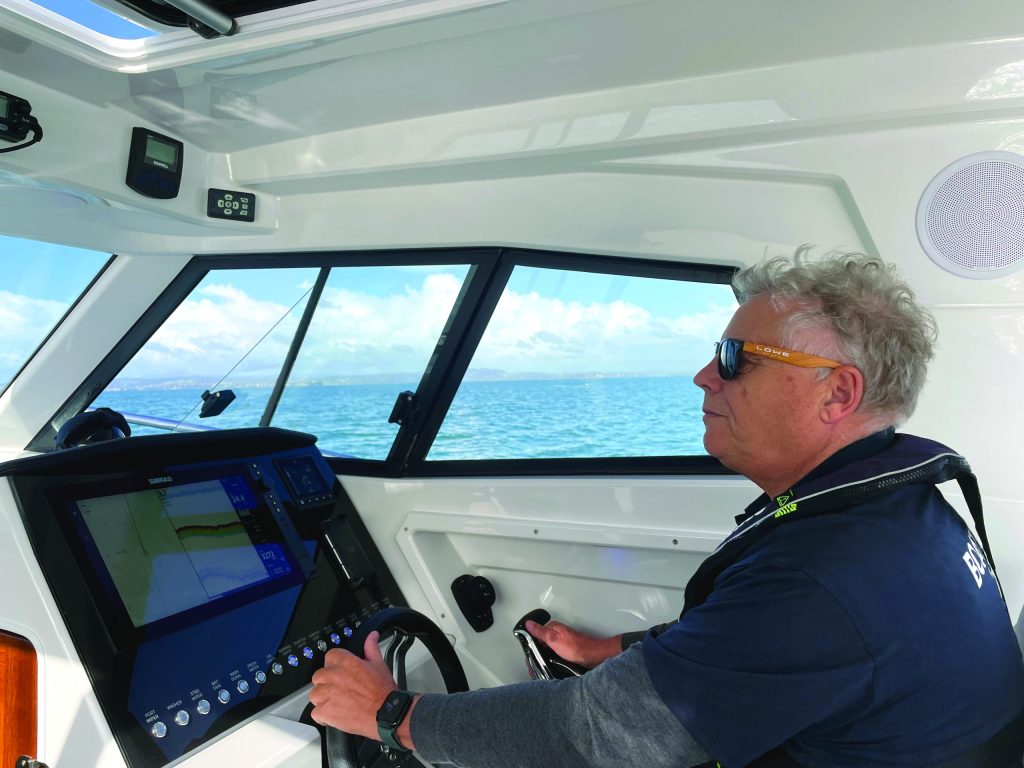
For the 2700, Rayglass has raised the chine line and added more flare to the bow. The result is a generally drier ride in most conditions and easier handling in a following sea. The ride is excellent from both boats, though there is perhaps a little more bow lift from the outboard. The review vessel was fitted with a Seakeeper Ride system and we also made use of Mercury’s auto trim function.
Of the two, the outboard vessel was definitely the quieter underway, and as mentioned, the more engaging to drive, but also thirstier. While the photography for this article was conducted elsewhere on a different day, we experienced a fairly typical short, steep Hauraki Gulf wind chop on our run to and from Waiheke Island’s bottom end. On the way home, the building wind and sea were right on the nose, but the pair of Legend 2700s made light work of it. Indeed, we were perfectly comfortable skipping across the waves at 30 knots, though the suspension function on the captain’s seats was welcome. No need for the windscreen wipers, either, as we didn’t get a drop of spray on the glass. The modified chines and extra bow flare have certainly resulted in a dry boat.
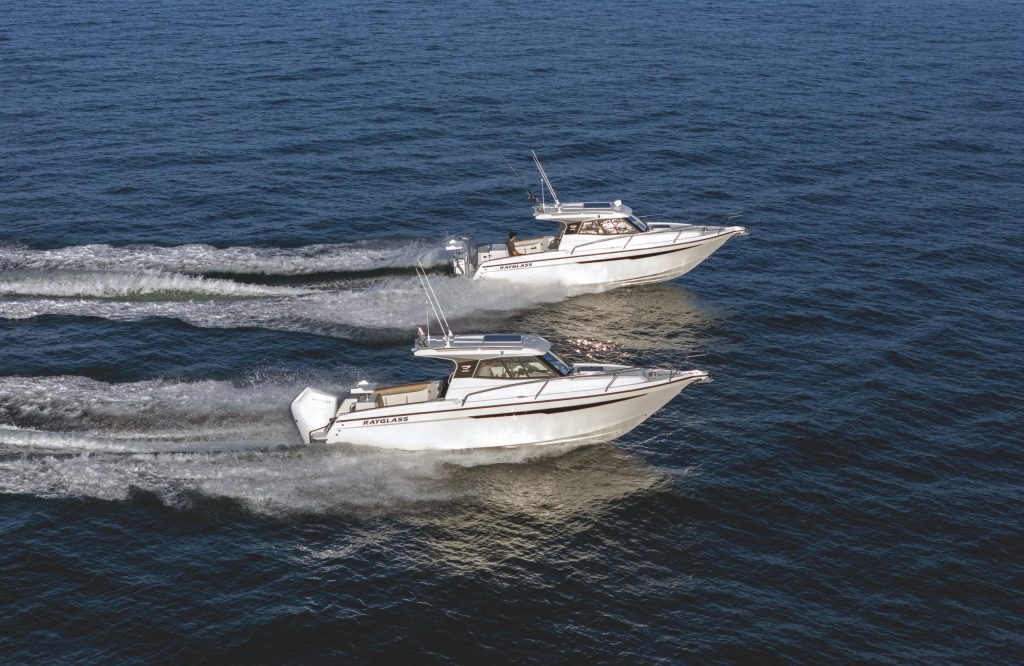
Which Legend?
Interest for the Legend 2700 (and the 3000) has been strong, says Rayglass Sales Manager Matt Flanagan, here in New Zealand and in Australia, where Rayglass recently appointed two new dealers. In New Zealand, orders have been 50-50 for diesel and single outboard versions, with most outboard customers opting for the 400hp V10 (Rayglass offers a Mercury 300hp V8 option as well. Australian customers are more likely to choose the twin outboards (2 x 200hp or 2 x 225hp).
Many customers are downsizing from a larger motor launch, says Flanagan, and one of the aims for the new 2700 and 3000 models was to make that transition as painless as possible. To this end, Rayglass has prioritised comfort and utility: “Everything in this boat just makes sense – everything works,” explains Hembrow, who had considerable input into the new models. “It allows you to get out of your own way and enjoy being out on the water.”

But which would you choose? The diesel offers excellent range, comfortable cruising, and a more fishing-oriented transom layout. It arguably delivers a slightly better ride, too, with the weight of the engine low down in the hull.
But the outboard version, while less fuel efficient, offers superior performance and exciting handling, especially the V10 with its huge propeller and great torque. Twin rigs are probably similar in performance and handling, though perhaps a little less chuckable.
The dark horse is the 350hp petrol V8 sterndrive version, coming soon. Probably as fuel-efficient as any of the outboards, perhaps more so, it should have similar handling characteristics to the diesel and the same transom options, but with less noise and more refinement.
A difficult choice indeed.
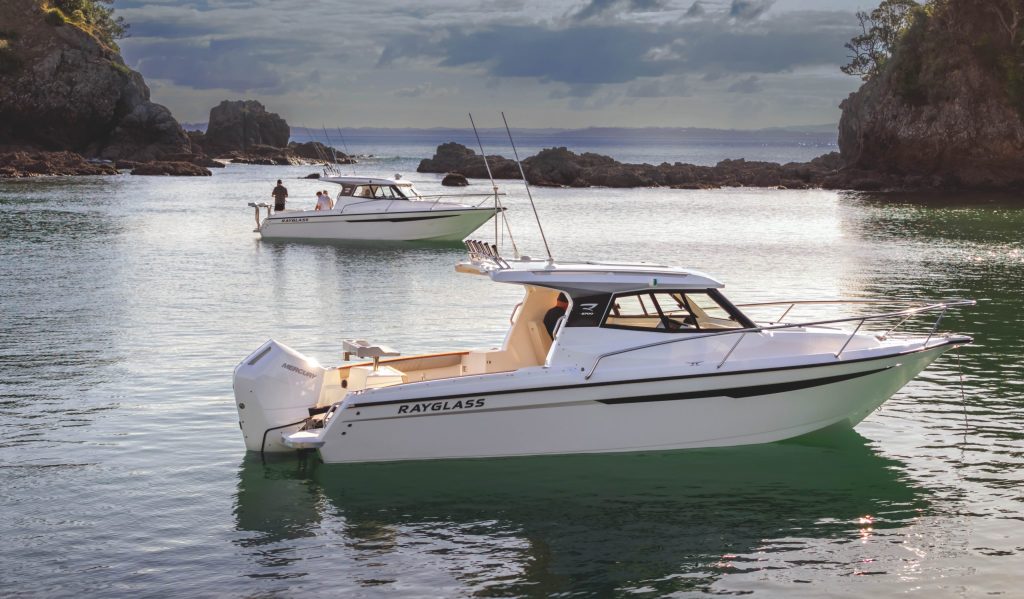
Pretty techie-cool, right?
Rayglass have gone full tech-mode and mapped every inch of the 2700—inside and out. Tap the link to take the full virtual tour, no shoes required.









